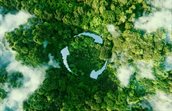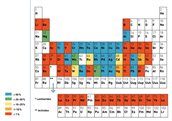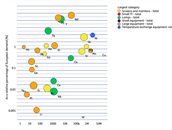Circular economy
A circular economy can contribute to greater security of supply. This, alongside reducing the negative environmental impact of our consumption, is the main goal of the Dutch government's circular economy initiative. Circularity is not just about recycling. It also includes measures designed to:
- ensure the more efficient use of raw materials;
- encourage product sharing and product-as-a-service concepts (where businesses do not sell products, but offer them as a service);
- extend the lifespan of products.
Recycling rate
The Critical Raw Materials Act (CRMA) seeks to boost recycling so that recycled products meet 25% of Europe’s needs forraw materials. At the same time, the recycling rate for many critical materials is low or unknown. A UNEP report published in 2011 shows that many materials are not recycled.
There is an urgent need for a clearer picture of the potential to extract secondary raw materials from waste streams, particularly for the Netherlands as a country with a large 'stock' of materials in our waste streams.
The figure on the right shows recycling rates from the previously mentioned UNEP report from 2011. The recycling rate is the proportion of materials from end-of-life products that are recycled. Many raw materials have a recycling rate of less than 1%, while some raw materials such as iron, copper and zinc have an estimated recycling rate of more than 50%. More information on this figure can be found in the UNEP report.
Source: United Nations Environment Programme, Recycling Rates of Metals - A Status report, 2011
What does the NMO do?
The NMO works with partners from the recycling chain and the research community to analyse how the Netherlands (and neighbouring countries) can contribute towards increasing recycling contributions and, by extension, the CRMA targets. The first steps have been taken in collaboration with Stichting OPEN, based on insights into the flow of Waste Electrical and Electronic Equipment (WEEE). As a result, preferred products can be selected and targeted advice can be provided on opportunities to increase the contribution made by recycling. For more information, see the report 'Activating strategic raw materials recovery: the case of electrical and electronic equipment'.
The NMO not only focuses on WEEE, but also other waste streams. In addition, it analyses and monitors the impact of technological and policy developments. The NMO, in close collaboration with the Netherlands Environmental Assessment Agency (PBL) and Circonnect, also contributes to the progress of Dutch Circular Economy policy. It does this by helping to collect relevant information and analysing how this policy affects supply security in the Netherlands.
The figure on the left shows the position of the Netherlands for various CRMs (Critical Raw Materials) and SRMs (Strategic Raw Materials). In the figure, the X-axis (logarithmic) shows the quantity of a CRM (kg). The Y-axis shows the relevant percentage of the CRM relative to current primary demand in the EU (%). Materials with a black circle are strategic materials. The colour indicates the waste stream where the CRM is most highly concentrated. More information on this figure can be found in the report 'Activating strategic raw materials recovery: the case of electrical and electronic equipment'.
Source: TNO, Activating strategic raw materials recovery: the case of electrical and electronic equipment, 2025.
Circular electrolyzers
Alongside a broad emphasis on recycling, the NMO will pay more specific attention to products through targeted research. It also focuses on the role recycling and circularity play in increasing supply security in the development of these products. A specific example is the analysis of circular electrolyzers. For more information, see the case study 'Towards circular electrolysers' (in Dutch).


